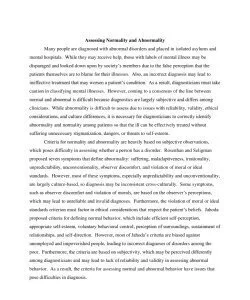Assessing Normality and Abnormality
Assessing Normality and Abnormality
(0.57). (0.80), 131 16 19 41 50 89 Abelson Abnormalities Abnormality All Also, As Asia Asians Assessing Chinese Clinicians Confirmation Criteria DSM DSM-III DiNardo Diagnosticians Ethical For From Furthermore, He However, If In Jahoda Jahoda, Jahoda’s Kleinman Langer Lipton Many Most New Normality OCD Otherwise, Rack Reliability Rosenhan Rosenhan, Seligman Seligman, Seven Simon Some Symptoms The Therefore, They This Thus, Two Western When While York a abilities ability able abnormal abnormal, abnormal. abnormalities abnormality abnormality, abnormality. abnormality: about abused, account accuracy accurate achieve act actors adding addressed admissions admitted admitting affected affective affects against agreed ailment, ailments, all also although among an and another anxiety any appeared applicant appropriate are as assess assessing assessments associate associated asylums at attempt attributing base based be because before behavior behavior, behavior. behavioral behaviors being beliefs. between bias bias, bias. biased biases blame blindness, bodily both boundary bring bringing but by can cannot career caring carried causation cause-and-effect caution cautious certain challenges chance, characteristics charismatic charismatic, classification classifying clinicians clinicians. collectivist coming compared comparison complaining completely conceived concerning conclusion conclusions, condition condition. confidentiality confirmation confounding consensus consideration considerations considerations, considered consist control, controlled convincing correctly correlational could create criteria criterion cross-cultural cross-culturally. crucial. cultural culture culture, culture-based culture-based, culture-bound culture-specific culture. cultures cultures, cultures. dangers, deception decipher define defining degrees dehumanize demonstrate demonstrated demonstrates demonstrating depression depression. determine determined diagnose diagnosed diagnoses diagnoses. diagnosing diagnosis diagnosis, diagnosis. diagnostic diagnostician diagnosticians diagnosticians, diagnosticians’ diagnostics did differ differences differences, different differently differs difficult difficulties difficulty discomfort discomfort, discontinuity, discovered disease, disease. diseases, disorder disorder. disorders disorders, disorders. disparaged disparity does down due effective effective. effectively effects efficient eight either else emotional emphasizing erroneous especially ethical ethics ethics, even evidence example experiment fact factor factors factors. fake faked faking false five for form forms four fraudulence fraudulent. from fully general generalizable generalized given, great groups had harm has have he he/she health, hearing heavily help, high him him/her his his/her honoring hospital hospital. hospitals hospitals. how ideal identify identifying ill ill, ill. illness illnesses illnesses. importance important impoverished in include inconsistencies inconsistent incorrect incorrectly individualist ineffective influenced information insight institutionalization interculturally. into invalid involve irrationality, is isolated issue issues it it. itself job label labeled labels lack largely lead leading limited line lived looked lower made made, main majority make makes making maladaptiveness, man manifest manipulate manipulation manner may members men mental mentally misdiagnose mistakes mood moral morals, more most must necessary negative nonexistent normal normality not o observations observations, observer observer’s obsolete occurred of often older on one only optimal or original other others out overpathologizing overreact own participants patient patient, patient. patients patients, patients’ patient’s people people, perceived perception perceptions perceptions, person personal person’s physical placed play poor. pose poses posing positive positive, prejudices prejudices. presented pressure prevalent prevent primarily prioritize problems problems. procedure procedures produces prophecy proposed proposes protection protection, provide provides pseudo-patients, psychiatric psychiatrist qualities. quantitatively question rate rate, rates re-diagnosed real reasons receive received relationship relationships, reliability reliability, reliable reliable, reliance report reporting require required researcher respect result result, results reveal ridicule rights. same sample schizophrenia schizophrenia, schizophrenia. scope. scrutinize self-direction. self-esteem, self-esteem. self-fulfilling self-perception, separates series seven several shows six size, small so society’s solid somatic some staff. staff’s standardize standardized standards standards. states stigmatization, stigmatize stigmatized, story stripped strong studied study subjective subjective. subjectivity, such suffering suffering, surroundings, suspected sustainment symptoms symptoms, symptoms. syndromes, system system. systems systems. take takes tape telling tend tends than that that, the their them themselves then there these they this those though threatening threats three through times, to told traits traits, traits. treated treatment treatment. trend, tw two type uncommon unconventionality, under undergo understand unemployed unnecessary unneeded unpredictability unpredictability, unreliable upon use used utilize valid, validity validity, variable variables variables. varying very viewers viewers, views. violated, violation violations voices. voluntary wary was way, ways were when where whereas whether which while who why widely with without women worse worsen yet yield young
Assessing Normality and Abnormality
Many people are diagnosed with abnormal disorders and placed in isolated asylums and mental hospitals. While they may receive help, those with labels of mental illness may be disparaged and looked down upon by society’s members due to the false perception that the patients themselves are to blame for their illnesses. Also, an incorrect diagnosis may lead to ineffective treatment that may worsen a patient’s condition. As a result, diagnosticians must take caution in classifying mental illnesses. However, coming to a consensus of the line between normal and abnormal is difficult because diagnostics are largely subjective and differs among
